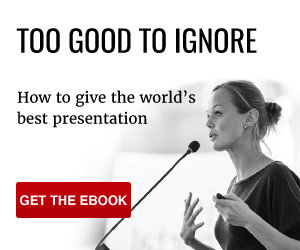Everyone’s been on the receiving end of a terrible PowerPoint presentation. That is undoubtedly what has given the program such a bad reputation. But what causes them to be so ineffective? Simply put, these bad presentations are a result of people not knowing how to use PowerPoint correctly. (Ironically, even Bill Gates doesn’t quite know how to use the software yet.)
One of the worst mistakes a presenter can make is to rely, or base their presentation, on a PowerPoint deck. Any visual aid you use alongside your verbal presentation is a resource for your audience, not yourself. It must summarise your presentation, reinforce your story and clarify the points you make. It is not a transcript or a cue card to refer to.
In order to create a successful PowerPoint presentation, you need an engaging presentation. Without a key focus, clear structure or story, PowerPoint is useless. So before you create a visual aid, ask yourself these questions:
- Can you clearly identify the core message of your presentation?
- Are you telling a story?
- Are your points ordered correctly?
- Is it engaging?
If you answer yes to all of these, you’ve got a basis to build a PowerPoint or visual aid on.
How to create a great PowerPoint presentation
A PowerPoint presentation should contain no more than 10 paper slides: longer than that and you’re overloading your audience with too much information. In fact, it’s scientifically proven that we are incapable of concentrating on verbal and written content at the same time. So if you do have additional information, add it to your appendix instead.
Remember: your verbal presentation is your priority and your visual aids are there to reinforce, not add to your point. That said, appropriate visual aids can be very helpful to the 65 percent of us who identify as visual learners. Just don’t make your screen slides too overwhelming. For the benefit of your audience, you need to make these visuals appealing and easily consumable. You needn’t restrict yourself to only 10 slides, so long as every slide contains relevant visual aids.
Here are some useful tactics to consider when creating a PowerPoint correctly:
- Don’t use too many words. Your audience should receive all the information they need from you. Your PowerPoint is there to help them remember the key facts or concepts. Therefore, keep any written content within your PowerPoint to a minimum; each slide should contain six or fewer lines of text.
- Use appropriate fonts and font size. Sans serif is an easier font type to read on a screen. But no matter what font you use, make sure it’s big enough to read. The audience members at the back of the room shouldn’t have to squint.
- Design your slides with your audience in mind. Don’t add too many colours to your presentation, as this can be distracting and unappealing. You want your text to perfectly contrast with your background so that it stands out. A plain black background with white text is as simple as it needs to be.
- Whitespace. You need to leave a ‘visual breather’ around your text to aid clarity. Too many distractions can make your words difficult to read.
- Insert images. Relevant visuals are a great way to tell a story and summarise your points. A legal expert training bankers about fraud, for example, just needs a picture of prison bars to get his point across. Images and infographics (visual representations of data) also help your message stick. The Picture Superiority Effect suggests that images help people remember 65 percent of information; when using only text, people are only able to recall 10 percent.
- Summarise statistics with charts. It’s helpful to visualise numbers and trends but try to only use one chart – rather than six. Keep your audience focused on the key information. Charts should be both informative and easy to understand. The Financial Times suggests, ‘When you need a graphic to illuminate a complex subject for your audience, the goal should be clarity rather than simplicity’.
Be prepared to bare all
Of course, PowerPoint slides aren’t always necessary. Sometimes the message is more powerful if you ‘go naked’. Presenting in front of a blank screen directs attention and asserts dominance back to you. It’s your presentation, so don’t hide behind PowerPoint. Use it as a prop when you need to, but never use it as a crutch.

